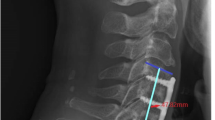Summary
¶ The Cloward ventral interbody fusion is often employed for treatment of cervical degenerative disease. The present study was aimed at evaluating results and complications in this classical type of autologous bone graft procedure in a cohort of patients with radiculopathy (RP) or myeloradiculopathy (MRP). Indications for and limitations of the technique were investigated by retrospective data analysis in a series of 106 patients (30 females and 76 males). These underwent single or multiple level Cloward fusion in a total of 145 levels. Neuroradiological investigations included lateral and antero-posterior cervical spine X-rays, axial CT scans, and MRI. The presence of postoperative ossification and stable bony fusion in the fused segments was confirmed by X-rays and, when necessary, by CT. The median postoperative follow-up period was 6.5 years (range 4–10.5 years).
Short term outcome in RP patients was good in 26 cases (92.9%) and fair in 2 cases (7.1%). A good short term outcome was seen in 55 MRP patients (70.5%), a fair outcome in 20 patients (25.6%), and a poor outcome in 3 patients (3.8%). Patients having myelopathy signs for less than 1 year had a significantly better outcome than those with clinical signs for more than 1 year (p<0.05). MRP patients below the age of 40 years had a significantly better outcome than those above the age of 40 (p<0.05). In the long term, radiculopathy was cured or significantly improved in 92.8% of cases, and myeloradiculopathy in 64%. One year after surgery, there were 139 stably fused segments (96%) and 6 segments showing osseous non-union (4%). Plain lateral radiographs demonstrated, besides the bony fusion in the respective segment, relatively frequent graft collapse with slight to severe correction losses and kyphotic deformity of the cervical spine. However, these findings did not necessarily correlate with the clinical outcome. Autologous bone graft harvesting caused a rather high short-term morbidity with donor site pain and/or wound haematoma in 33% of the cases. These surgery-related complications, however, were of a temporary nature, as long-term complications (cutaneous hypaesthesiae) were found in 2 patients (1.8%) only.
In conclusion, Cloward anterior cervical fusion for degenerative spinal disease is a relatively simple and safe surgical procedure with favourable short and long term results. In our hands, graft donor site complications dominate the side effects of surgery, and the percentage of non-unions is rather low. Because of the relatively frequent bone graft collapse and the late loss of postural correction of the spine, we cannot recommend the Cloward type fusion for multisegmental procedures. In such cases, an instrumented plate fusion should be carried out in order to prevent graft collapse and non-union, and to allow for a shorter convalescence period.
Similar content being viewed by others
Author information
Authors and Affiliations
Rights and permissions
About this article
Cite this article
Heidecke, V., Rainov, N., Marx, T. et al. Outcome in Cloward Anterior Fusion for Degenerative Cervical Spinal Disease. Acta Neurochir (Wien) 142, 283–291 (2000). https://doi.org/10.1007/s007010050037
Issue Date:
DOI: https://doi.org/10.1007/s007010050037




